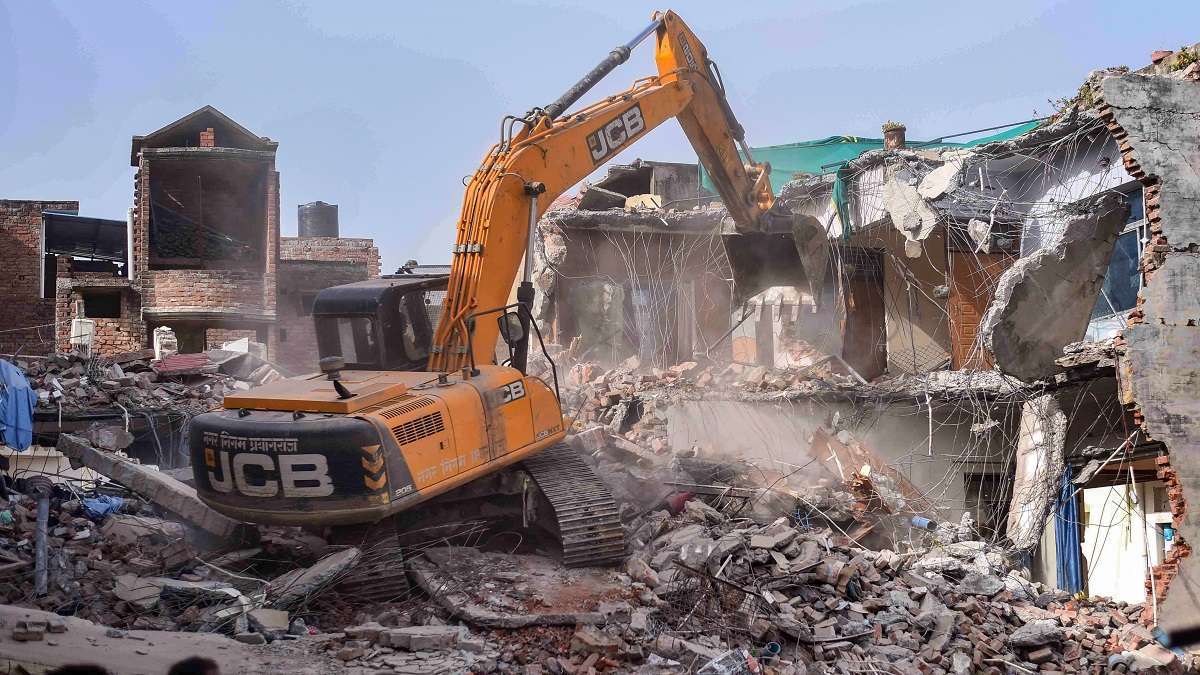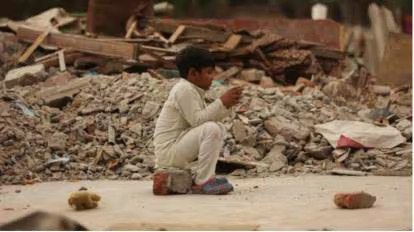Bulldozer Politics and the Erosion of Constitutional Morality in India

This couplet, penned in the aftermath of communal riots, echoes with greater urgency in today’s India—an India where the very meaning of justice is being bulldozed under the wheels of retribution. A home, once a symbol of security and aspiration, is now being reduced to political rubble in broad daylight, often in front of news cameras, cheered on by crowds, and sanctioned by silence.
What began as rogue demolitions has now been institutionalized as a model of governance, most prominently in states governed by the Bharatiya Janata Party. This model, which many have come to call “bulldozer justice,” pretends to serve swift accountability but often sidesteps courts, laws, and most dangerously—human dignity. It claims to punish the guilty, but in practice, it punishes the voiceless. What justice is this, where there is no trial, no hearing, no defense—just a machine flattening livelihoods in the name of order? Is this justice, or state-sponsored vengeance? Can a democratic republic tolerate a system where punishment is dictated not by courts but by camera crews and election rallies? When bulldozers move faster than legal notices, is it law that is working—or power?
This form of justice is not blind. It sees exactly who to target—often minorities, slum dwellers, street vendors, and the politically marginalized. In places like Jahangirpuri, Kalkaji, Haridwar, and Haldwani, the message has been clear: those who cannot count in votes, or buy influence, can be counted out of rights.
Chief Justice B.R. Gavai, in Milan in 2025, reminded the world that “a house is not just a property—it embodies the collective hopes of a family for stability, security, and a future.” And yet, in the land of the Constitution, we now see hope being demolished without hearing, without warning, without shame.
From Crime to Spectacle:
The phenomenon traces its origins to 2020, when gangster Vikas Dubey’s house was razed after he masterminded the killing of eight policemen in Kanpur. That demolition, conducted without any formal legal procedure, was broadcast across news channels and celebrated as swift state action. It soon set a precedent. In the 2022 Uttar Pradesh elections, the bulldozer became a campaign icon. Chief Minister Yogi Adityanath proudly embraced the moniker “Bulldozer Baba,” signaling zero tolerance toward crime. But this symbolic hardline approach soon crossed a line—from symbolism to selective targeting.
In Delhi’s Jahangirpuri, bulldozers rolled in just days after communal violence, flattening homes even as the Supreme Court issued a stay. In Madhya Pradesh, shops belonging to alleged rioters were demolished in the aftermath of similar unrest. In Uttarakhand’s Haldwani, entire working-class settlements near railway tracks faced eviction, forcing the Nainital High Court to intervene. What ties these cases together is the bypassing of judicial oversight and procedural safeguards.
The Supreme Court, alarmed by the pattern, delivered a decisive ruling in 2024. It affirmed that demolitions without a prior show-cause notice and without giving residents a chance to be heard violated Article 21 of the Constitution—the right to life and shelter. It mandated a 15-day response window before any demolition, required documentation and justification, and warned that contempt charges could apply to officials who defied these orders. Yet, the bulldozers continue to roll. A 2025 study by the Centre for Policy Research revealed that more than 1,200 demolitions had been carried out in BJP-ruled states since 2020, and less than a third complied with legal norms.
What should have been an exceptional act under judicial oversight has instead become an executive reflex—punitive, political, and public. Bulldozers are no longer clearing encroachments; they are clearing dissent, disempowerment, and above all, the promise of due process.
Constitutional Betrayals:
Legal experts have sounded the alarm about the constitutional violations inherent in bulldozer justice. Former Supreme Court judge Justice Madan Lokur called the practice “a form of mob rule with state sanction,” warning that punishment without trial is incompatible with democratic governance. Senior advocate Indira Jaising highlighted that such demolitions breach not only Article 21 but also Article 14, which guarantees equality before the law, and Article 300A, which protects the right to property. She emphasized that holding an entire household accountable for the alleged wrongdoing of one member is fundamentally unjust and unconstitutional.
What is being practiced under the banner of law and order is, in many cases, collective punishment—a principle alien to India’s legal framework. And yet, the state continues to deploy bulldozers to project strength, bypassing courts and ignoring the Supreme Court’s own instructions. Chief Justice Gavai, reiterating the court’s position, noted that socio-economic justice is not an act of benevolence from the state—it is a constitutional obligation. When a home, often the result of a lifetime of labor, is razed without trial or rehabilitation, it amounts to an assault on human dignity.
Even more troubling is the demographic pattern behind the demolitions. Reports and field investigations indicate that a disproportionate number of razed homes and shops belong to minority communities or economically vulnerable groups. This selectivity corrodes the principle of equality and feeds narratives of systemic discrimination. In essence, the bulldozer is being weaponized not merely to enforce the law, but to send a message—one that targets the weak and bypasses the judicial process altogether.
Despite repeated judicial pronouncements, enforcement remains toothless. There is no independent oversight, no public record of how many demolitions comply with the law, and no significant instance of accountability for illegal actions. The judiciary has spoken, but the state machinery seems increasingly deaf.

When Policy Becomes Punishment and Homes Become Rubble
The consequences of bulldozer justice go far beyond the loss of property. It is a humanitarian crisis in the making. In Delhi’s Kalkaji, over 350 families were rendered homeless in 2025 despite having valid documentation. Displaced overnight, they now live in temporary shelters with no clarity on rehabilitation. In Uttarakhand, evicted families continue to wait for the flats promised by the courts, while enduring harsh conditions and dwindling hope. This is not law enforcement—it is institutionalized dispossession.
The economic consequences are equally devastating. A 2024 study by the National Law University found that each demolition displaces an average of 5.6 individuals. Within three months, 90% of those displaced lose access to education, healthcare, or employment. Informal workers are uprooted from their client bases, women lose access to maternal care, and children are pulled out of schools mid-session. Families sink into a spiral of poverty from which it is almost impossible to recover. The bulldozer, in this context, is not a machine of justice—it is a machine of marginalization.
Urban planner Gautam Bhan warns that this approach is not just legally flawed but economically ruinous. By destroying informal settlements and markets, the state destroys the micro-economies that power India’s urban engine. Communities that take decades to build are dismantled in hours, without any plan for integration or compensation. It is, in Bhan’s words, “a governance model built on ruins.”
Even within the ruling BJP, concern is growing. A senior leader, speaking on condition of anonymity, admitted that the bulldozer wins headlines but cannot build long-term governance. “What looks like strength today will be remembered as injustice tomorrow,” he said. Yet, in the absence of electoral consequences or judicial enforcement, the state continues to prioritize spectacle over substance.
Restoring the Constitutional Spine of Justice
India finds itself at a constitutional crossroads. The bulldozer, once a symbol of growth, has become a metaphor for democratic backsliding. The judiciary has issued clear guidelines, but its authority is increasingly undermined. The executive bypasses courts with impunity, turning legal process into a liability and justice into public theater. The Constitution guarantees protection, dignity, and housing—not for a select few, but for all citizens.
To restore constitutional morality, four urgent shifts are required. First, justice must be rooted in process, not performance. The executive must obey the courts, and courts must assert their authority. Second, demolitions must be accompanied by rehabilitation. The state cannot reduce families to homelessness and walk away. Third, Parliament must step in to legislate clear, enforceable rules governing demolitions and housing rights. Finally, citizens, civil society, and the media must reclaim the moral narrative. The bulldozer may be loud, but the Constitution speaks with deeper authority.
India’s democracy cannot afford to let machines replace judges or reduce justice to rubble. The rule of law is not an optional ideal—it is the bedrock of the republic. If that foundation is cracked by the wheels of a bulldozer, what remains is not order, but silent chaos.
(The author is our Managing Editor )

 1 month, 1 week ago
1 month, 1 week ago











[[comment.comment_text]]